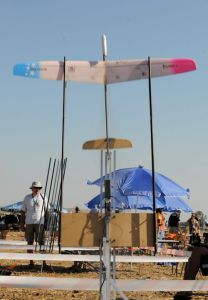Hello,
I'm new to the forum. I don't have any real experience with with rockets other than online reading so I have a few questions about my new project. I have a Libelle Discus Launched Glider. It flies great, however, I am rarely able to hand launch the glider high enough to catch any significant ridge or thermal lift. So I'm working on a rocket boost system based on Estes 1/4 A3-2T motors. I could just get another model but that would be as much fun.......:eyeroll:
I have molded a "pod" out of thin fiberglass as well as a rocket motor tube that weighs in @ 1oz. Due to its shape the pod is very strong and will easily survive firings and landings. It will be mounted to the fuselage by two dowels and a nylon screw. The rocket motor tube will be "capped". The model requires a little over an ounce of weight in the nose so the weight of the pod/rocket motor should not require much if any counter weight...
I put a cotton wad over the ejection charge and caped the front end of the 1/4 A3-2T motor closed with hot glue. Hand launching the glider results in approximately a 2g acceleration so I don't think that this motor will over-stress the airframe in a stable flight attitude as the models flying weight is approximately 11oz.
My questions are:
1. What is the best angle to mount the motor in the pod? I'm guessing about a 10 to 20 degree down angle to keep the exhaust gasses away from the airframe. Can anyone comment on this?
2. Since my onboard battery is 5v and limited current I don't think that will be enough to fire the igniter. Has anyone done anything with an application like this? Weight is a concern so additional batteries aren't really an option. I haven't experimented with it yet, but I thinking of creating a small circuit to use the discharge of a capacitor to fire the igniter triggered by an ultra micro servo as the switch.
Here are some picture of the project so far. Thanks all input is appreciated.




I'm new to the forum. I don't have any real experience with with rockets other than online reading so I have a few questions about my new project. I have a Libelle Discus Launched Glider. It flies great, however, I am rarely able to hand launch the glider high enough to catch any significant ridge or thermal lift. So I'm working on a rocket boost system based on Estes 1/4 A3-2T motors. I could just get another model but that would be as much fun.......:eyeroll:
I have molded a "pod" out of thin fiberglass as well as a rocket motor tube that weighs in @ 1oz. Due to its shape the pod is very strong and will easily survive firings and landings. It will be mounted to the fuselage by two dowels and a nylon screw. The rocket motor tube will be "capped". The model requires a little over an ounce of weight in the nose so the weight of the pod/rocket motor should not require much if any counter weight...
I put a cotton wad over the ejection charge and caped the front end of the 1/4 A3-2T motor closed with hot glue. Hand launching the glider results in approximately a 2g acceleration so I don't think that this motor will over-stress the airframe in a stable flight attitude as the models flying weight is approximately 11oz.
My questions are:
1. What is the best angle to mount the motor in the pod? I'm guessing about a 10 to 20 degree down angle to keep the exhaust gasses away from the airframe. Can anyone comment on this?
2. Since my onboard battery is 5v and limited current I don't think that will be enough to fire the igniter. Has anyone done anything with an application like this? Weight is a concern so additional batteries aren't really an option. I haven't experimented with it yet, but I thinking of creating a small circuit to use the discharge of a capacitor to fire the igniter triggered by an ultra micro servo as the switch.
Here are some picture of the project so far. Thanks all input is appreciated.








